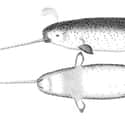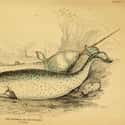-
(#1) Narwhal Tusk Size Is Related To Testicle Size
It's hard to make sense of narwhal tusks. Most male narwhals have them, but not all. A small portion of females have them, too, but they're smaller. Is there any connection between tusks and narwhal behavior? Not really; narwhals with and without tusks appear to eat the same, and tuskless narwhals survive just as well as those with them. So... what gives?
Scientists are unclear about a lot of this, but one thing is for sure: the bigger the tusk, the bigger the testicles. And tusks may play a role in which male narwhal females choose to mate with. That's a fact. -

(#2) Narwhal Blubber Tastes Like Hazelnuts
Do you enjoy Nutella? You might want to check out narwhal! A layer of narwhal skin and blubber eaten raw (an Inuit delicacy) supposedly tastes like hazelnuts. Narwhal meat (called mattak) is still a vital source of food for people and dogs in Greenland. -
(#3) Narwhal Tusks Used To Be Sold As Unicorn Horns
Let's get one thing out of the way: narwhals totally exist. Unicorns totally don't. Got it? But the existence of narwhals made people think for a long time that unicorns did, in fact, exist.
Why? Well, medieval Europeans didn't exactly have regular access to narwhals. Narwhals live in cold, remote locations, so only Vikings and traders knew about them. This made it easy for merchants to dupe people into thinking they were buying a "genuine" unicorn horn. It's no coincidence that early depictions of unicorn horns look just like narwhal tusks, down to the distinctive spiral.
-

(#4) Some Narwhals Don't Have Tusks
When you think of narwhals, you think of their massive tusks, right? But did you know that some narwhals are tuskless? Scientists aren't quite sure why, which makes trying to figure out what the tusk is used for even more difficult. If the tusk were essential for survival, wouldn't they all have them?
And why do female narwhals - of which only 3 percent have tusks - live longer than the males?
-
(#5) Some Narwhals Have Two Tusks
Most male narwhals (and 3 percent of females) have one giant nine-foot-long tusk - which is actually a left canine tooth - sticking out of their mouths. That's pretty weird, eh? What's weirder is that the right canine tooth usually doesn't stick out, but instead remains embedded in the narwhal's skull. When it does stick out, however, you get a rare two-tusked narwhal. -
(#6) Narwhal Tusks May Actually Be Sensory Organs
Scientists don't know for sure what, exactly, a narwhal uses its tusk for, but some of the latest research suggests it may be a sensory organ. A narwhal's tusk is heavily enervated, meaning it's super-sensitive. This makes researchers think narwhals may use their tusks as built-in weather stations, detecting changes in temperature and barometric pressure.
Rubbing tusks together may also be a pleasurable activity for male narwhals. They may also be used for mating rituals with females.
-

(#7) Narwhals Have No Visible, Useful Teeth In Their Mouths
A narwhal's giant, protruding tooth is definitely its most distinguishing feature, but did you know that narwhals don't use that tooth at all for eating? Narwhals actually have to eat their food whole because they don't have any useful teeth in their mouth. The only teeth they have besides the giant tusk-tooth are vestigial, meaning they're totally useless.
Scientists are baffled as to why a narwhal would evolve to have one giant external tooth instead of 30-40 internal teeth.
-
(#8) No One Has Ever Seen A Narwhal Eat
Scientists only know what narwhals eat (halibut, cod, shrimp, squid, and not much else) because they have examined the contents of their stomachs. Otherwise, they wouldn't know for sure because no one has ever seen a narwhal eat.
Narwhals eat, we assume, at great depths in total blackness, underneath great sheets of ice, so humans have never witnessed them feeding.
-

(#9) Narwhal Means 'Corpse Whale'
Cool band name alert: "Narwhal" comes from an old Norse word meaning "corpse whale." Why "corpse whale"? Narwhals have black and white mottled skin, so some think "corpse whale" refers to their resemblance to the bodies of drowned sailors. Others think it may refer to their habit of "logging," which means lying inactive (like a corpse) just below the surface of the water. -
(#10) Narwhal Tusks Are Infested With Lice
Narwhals are notoriously hard to get close to, but there's one creature that gets up close and personal with them all the time: lice. Whale lice love to hang out around a narwhal's tusk, particularly around the base. Lice are the most common external parasite for a narwhal.
In fact, Fisheries and Oceans Canada says lice are "always" found on males in a ring shape around their tusks. Injured narwhals also have to contend with lice in their wounds. Yuck!
-

(#11) There Are No Captive Narwhals
There's a darn good reason scientists don't know much about narwhals: you can't capture them! Well, you can, but they die pretty quickly in captivity, so the whole enterprise is just cruel and useless. Narwhals can't handle the stress of captivity - the acidity and carbon dioxide levels in their blood fall and oxygen levels rise when they are captured. If narwhals are not returned to the ocean, their acidity, carbon dioxide, and oxygen levels never return to normal and they die.
Outside of captivity, narwhals can live to be 100, but if you put them in a tank, they don't last (the narwhal's cousin, the beluga whale, however, thrives in captivity). So if you want to see a narwhal in real life, don't bother looking at an aquarium: there are currently no captive narwhals, and there likely won't ever be. -

(#12) Narwhal Skin Is Rich In Vitamin C
Narwhal is a delicacy for Inuits, but it's not just about the taste. Surprisingly, narwhal flesh is full of vitamins and minerals. An ounce of narwhal has as much vitamin C as an orange! That helps explain why Inuits fill freezers full of narwhal meat for the winter and even feed their dogs with it.
The meat is so highly prized, in fact, that demand usually exceeds supply.
-
(#13) Narwhal Tusks Always Spiral To The Left
There are a lot of inconsistencies with narwhal tusks: some have one, some have two, some have none, some are longer than others, the list goes on. But there is one thing that is consistently true about narwhal tusks: they always spiral to the left. Even in the rare instance of a two-tusked narwhal, both tusks will spiral counterclockwise, every time, without fail!
Scientists say it's the only tooth in nature that defies "the principal of mirror-imaged morphology."
-
(#14) Narwhals Spend A Lot Of Time Swimming Upside-Down
When scientists attached cameras to some narwhals in 2007, they were surprised to learn that narwhals love to swim upside-down, especially when they're near the bottom of the ocean. About 80 percent of their time spent at the bottom of the sea is spent upside-down. Why? Scientists speculate that it may be a defensive maneuver to protect their tusks or jaws from hitting the ocean floor.
The downward angle of their tusks makes sense when swimming under ice, but near the bottom, they need to flip for safer swimming.
-
(#15) Inuits Can Legally Hunt Narwhals
Inuits have been freely hunting narwhals in the Eastern Canadian Arctic for about two millennia. In the 21st century, hunters use motorboats and snowmobiles to track them down before killing them with high-powered rifles. It's not an easy task: plenty of narwhals get shot but sink before they can be hauled in.
Up until the mid-20th century, narwhals were used as a primary food and fuel source, but now it's all about the tusks: people are willing to pay about $125 a foot to add them to their collections.
-

(#16) Narwhals Change Color As They Age
Much like human hair can get white or silver as we age, narwhal skin changes as they age. Senior narwhals, in fact, are almost entirely white. Middle-aged adults, meanwhile, are a mottled black and white. Juveniles are blue-black while newborns enter the world a blue-gray color. -

(#17) Narwhals Swim Slower Than Humans Walk
Manatees are typically called out as being the sloths of the sea, but did you know that you could outrun a narwhal just by walking? Narwhals swim about 3.8 miles per hour - slower than most people walk! They make up for their slow speed with killer stamina, though; their muscles actually resemble those of human endurance runners, with a high percentage of slow twitch muscle fibers.
They may take their time, but they can outlast most marine mammals when deep diving.
-

(#18) Narwhal Tusks Can Bend One Foot In Any Direction
Not only are narwhal tusks super-strong, they're also insanely flexible. That's right: the spear-like narwhal tusk isn't rigid! An 8-foot tusk can actually bend 1 foot in any direction. Remember: this is technically a tooth we're talking about. -
(#19) Their Heart Rate Drops When They're Frightened
Narwhals have a pretty unusual response when they're threatened. Their heart rate drops, but they swim away quickly.
That can have some negative effects on a whale's health. The low blood flow and decreased oxygen caused by the response can leave the whale disoriented, and even cause brain damage. Scientists theorize this "freeze, then flee" behavior is what leads to whales becoming stranded.
New Random Displays Display All By Ranking
About This Tool
A kind of whale in the world, with 2-3 meters long and sharp horns on its head which can easily pierce anything. They do not like to play on the surface of oceans like other whales, nor are they notorious for attacking humans like some whales. It is narwhals that were regarded as one of the most mysterious species in the Arctic Ocean. Their appearance is so incredible and becomes a unique creature in the deep sea.
The most striking feature of narwhals is the long teeth protruding from their heads, which not only be used as weapons but also as a symbol of family status. Here the random tool introduced 19 fascinating things about narwals that most people do not know.
Our data comes from Ranker, If you want to participate in the ranking of items displayed on this page, please click here.



















